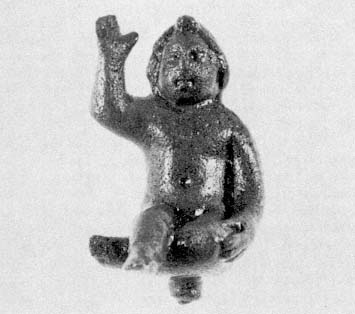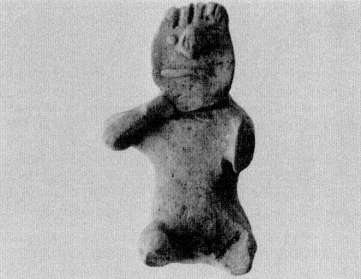Case 4:
The Myths of Nemea
All ancient sites had their own myths, and the Panhellenic centers were no exception. The myths for Nemea are represented in the excavated material in case 4 on the west wall of the main exhibition hall. In Greek mythology, perhaps no hero is so enduring as Herakles, and his victory over the lion—the first of his twelve labors—clearly associates him with Nemea.[19] Because the skin of the lion was impenetrable, Herakles had to wrestle the lion and strangle him. Then, with the lions own claws, Herakles skinned the beast, thereafter wearing the skin over his back as a kind of armor (Alexander
[19] This myth was very popular and occurs frequently in art and literature. The earliest literary example is in Hesiod, Theogony , 327-32 (8th century B.C. ). It is interesting that Hesiod himself, warned by the Pythian oracle that death would overtake him in the fair grove of Nemean Zeus, avoided Nemea (cf. Thucydides 3.96.1 and Plutarch, Moralia 162D). Unfortunately for Hesiod, there was also a grove of Nemean Zeus at Lokris.
the Great adopted this same iconographical device in his coins; see case 3, C 337). One reads in general handbooks and guides that Herakles, as a thanksgiving to his father Zeus for his victory over the lion, established the Sanctuary of Zeus and the games. The only archaeological evidence of the myth discovered at Nemea consists of small bronze lions head attachments and a gold foil relief representation of Herakles' face with the lions skin tied under his chin (BR 1040 and GJ 26; see the photographic enlargements on the wall behind case 4). The paucity of evidence is not surprising, however, for the connection between Herakles' victory over the lion and the founding of the Nemean Games was not mentioned in ancient literature until the 1st century after Christ.[20]
The proper foundation myth for the Nemean Games has to do with a set of characters less well known but established well before the 5th century B.C. , when Aeschylus wrote a play about them, only the title of which survives. Of a later play by Euripides, Hypsipyle , perhaps a third has been preserved on a papyrus from Egypt, and that together with later texts gives us the following story.[21]
Once upon a time in Nemea there was either a priest of Zeus or a king named Lykourgos who, with his wife Eurydike, longed for an heir. After many years of frustration, a baby boy was born, and the happy couple gave him the name Opheltes. Lykourgos sent to Delphi to ask how he might ensure the health and happiness of his baby, arid the Pythian
[20] See Virgil, Georgics 3. 19 with scholium (Servius-Probus) ad loc . Attempts to use the texts of Callimachus, Victoria Berenices (text in ZPE 14 [1977] 1-50), and Euphorion apud Plutarch, Moralia 677A (= Powell, Collectanea Alexandrina 84), to establish a cause-and-effect relation between the lions death and the founding of the games are less than convincing. But even if such interpretations could be proved correct, the relation would still not be traced earlier than the 3rd century B.C.
[21] For the sources and discussion of the myth, see E. Simon, "Archemoros," AA (1979) 31-45; and W. Pülhorn, "Archemoros," LIMC II (Zurich 1984) 472-75. Note that it was known already to Simonides of Keos, to Pindar, and to Bacchylides.
oracle responded that the baby was not to be allowed to touch the ground until he had learned to walk.
Upon his return to Nemea, Lykourgos acquired a slave woman named Hypsipyle,[22] to whom he entrusted the care of the baby Opheltes, with the stipulation that he was not to be allowed to touch the ground. One day Hypsipyle was carrying the baby in the valley when she was approached by the Seven Champions, who were on their way from Argos to Thebes. They asked Hypsipyle for something to drink, and she led them to a spring or stream where she laid the baby down on a bed of wild celery (

Given this mythical background for the Nemean Games, it would not be surprising to find relevant physical evidence. Indeed, a small bronze figurine in case 4 (Fig. 7) must represent Opheltes; the pose of the figurine is similar to that of Opheltes on the Corinthian sarcophagus. Although the figurine belongs to the Hellenistic period, it was found south of
[22] This Hypsipyle has a history of her own. The daughter of King Thoas of Lemnos, she ruled the island and received the Argonauts on their (not always very energetic) quest for the Golden Fleece. She had two sons, Euneos and Thoas, by Jason, but after Jason's departure she was captured by pirates and sold to Lykourgos of Nemea. In the Euripidean version of the story she is rescued from Nemea by her two sons after a miraculous recognition; see Euripides, Hypsipyle (ed. Bond) 16-18 and 147-49.
[23] F. P. Johnson, Corinth IX, Sculpture, 1896-1923 (Cambridge, Mass. 1931) 114-19, no. 241. For more recent photographs, see Simon, op. cit . (n. 21) 40-41, Figs. 7-9.

Fig. 7.
Bronze baby Opheltes (BR 671).
the Temple of Zeus in earth disturbed in the 6th century after Christ. Its archaeological significance is therefore limited.
Much clearer is the evidence of the hero shrine, or Heroön, discovered southwest of the Temple and west of the Bath (no. 19 in the model; see pp. 34, 104-10). An aerial photograph (see Fig. 36) of this Heroön near case 4 shows it as a lopsided pentagon built of rectangular blocks overlying a curvilinear predecessor built of field stones (this structure is dearest at the lower left, or southwestern, corner of the photograph). The religious character of the Heroön was established by, among other evidence, the deliberate burial of a krater (P 539 in case 4) with a stone lid at the northeastern corner of the enclosure, next to the foundations. A photograph on the wall shows this krater at the moment of discovery. Its contents
may have included the beans which were set in such foundation trenches when a structure was dedicated to the gods.[24]
Within the enclosure were deposits of ash, carbon, and burnt bone from sacrifices and large quantities of other artifacts; another wall photograph shows some of this material during excavation. Everything in case 4, with the exception of the lion's head (BR 1040), the gold foil Herakles (GJ 26), and the figurine of Opheltes (BR 671), came from this enclosure. The miniature vessels are characteristic of the votives one might expect in a shrine, and the drinking cups (e.g., P 510) were used for libations poured out during sacrificial rites. The fragment of a terracotta column (AT 83) once supported a basin for holy water (perirrhanterion ), the rim of which may well have been inscribed with a sadly fragmentary dedication (P 547, a-f). The cup-skyphos (P 546), which bears an inscribed dedication by a victor as well as a magical inscription, also shows the decidedly religious character of this enclosure. The silver coins of Sikyon (C 1639) and Aigina (C 1645 and 1649) would also have been appropriate dedications in a shrine.
Even more suggestive, however, is the iron caduceus (IL 324), the symbol of Hermes Psychopompos, leader of souls to the underworld. It hints that the shrine is chthonic and heroic. The same conclusion derives from the lead curse tablets, two of which are displayed in case 4 (IL 327 and 367). Such curses are appropriately deposited in the shrine of a hero. The examples in case 4 bear erotic curses in which an anonymous author hopes to alienate the affections of a woman from another man. Thus IL 327 reads: "I am turning Euboula away from Aineas, away from his face, from his eyes, from his mouth, from his breast, from his soul, from his stomach, from his penis, from his anus, from his whole body am I turning Euboula away from Aineas."
[24] See Aristophanes, Plutus 1198 and Pax 923, and scholia ad loc . I thank C. Simon for this reference. See further p. 107, on the Heroön.

Fig. 8.
Terracotta baby Opheltes (TC 117).
To which hero was the shrine at Nemea dedicated? Pausanias, who visited Nemea in the mid-2nd century after Christ, found there a tomb of Opheltes within a peribolos which also contained altars. He defined the peribolos as an enclosure of stone (

To the fight of case 4, in the northwestern corner of the room, is the right half of a MARBLE RELIEF (SS 8), part of a dedicatory relief which had been reused in a house of the later 4th century B.C. (see p. 76 and Fig. 23). It portrays a male figure standing in front of a seated female. The figures have yet to be identified, and the date is in debate, although it is probably in the 460s B.C. Clearly the piece must stand early in the Classical period since it combines elements of the Classical, especially in the male figure, with elements of the earlier, Archaic, period, especially in the female figure. The male's clothing, for example, is plastic, the female's stiff and two-dimensional. The handling of depth is awkward both with regard to the female's feet and in the relation of her breast to her shoulder.